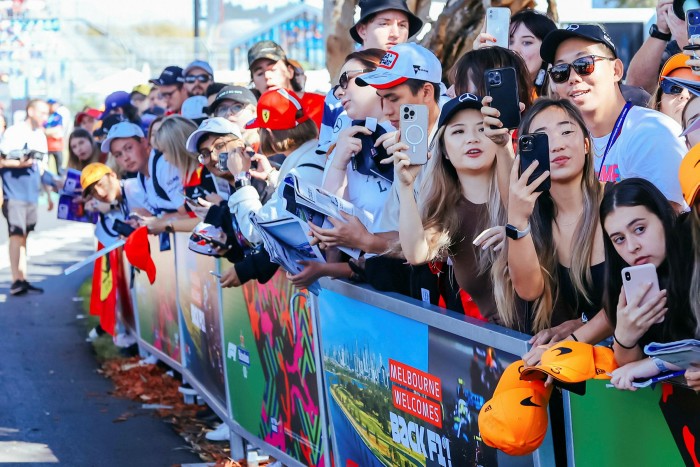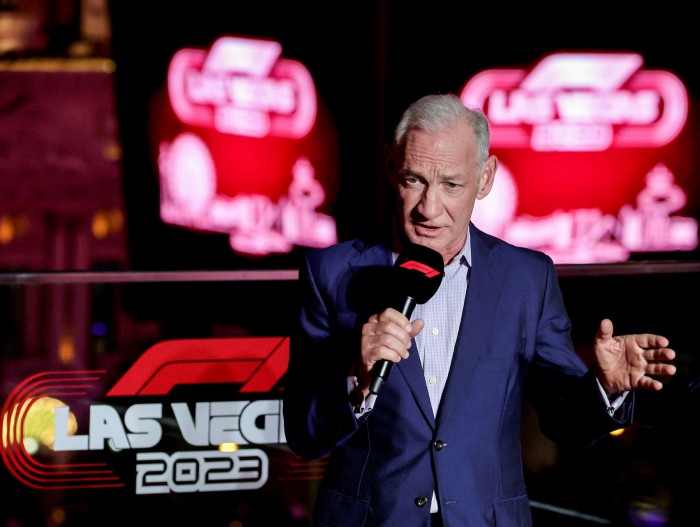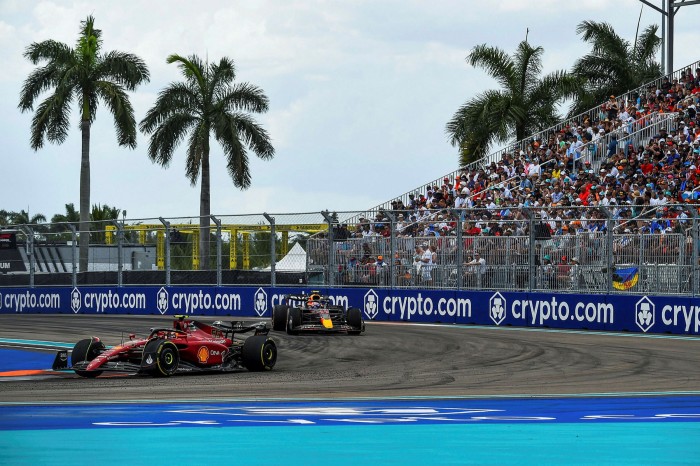Investors buy into Liberty Media’s F1 recovery plan

Roula Khalaf, Editor of the FT, selects her favourite stories in this weekly newsletter.
Not so long ago, Liberty Media — the company controlled by US billionaire John Malone — was pleading for patience as it tried to reinvigorate Formula One, the global car racing series.
Now, though, F1 is on a hot streak after a thrilling championship duel last year between Sir Lewis Hamilton of Mercedes and Max Verstappen of Red Bull, as well as this month’s inaugural Miami Grand Prix. It has also pulled in millions of new fans thanks to Drive to Survive, the fly-on-the-wall documentary from Netflix.
Liberty Media took a risk when it acquired F1 for $8bn including debt in 2017. The sport had been led for decades by Bernie Ecclestone, the former car dealer who turned F1 into a global phenomenon. “There were plenty of things we didn’t understand,” Greg Maffei, the chief executive of Liberty Media, tells the Financial Times. “But the things that mattered, we were right on.”
The sport was at risk of going stale when Liberty Media stepped in. On the track, Hamilton and his team were possibly too dominant, while Ecclestone had neglected social media and young fans in favour of an older male audience flush with cash. It left F1 needing to be more competitive and digitally sharp while increasing its appeal in the US.
“There was an opportunity [that], by creating a better on-track product [and] on-grid experience, you could make it more appealing both to fans, because it was more competitive, and also to investors in the teams,” says Maffei. “That would all create a flywheel that was to our benefit as well.”
But talks to alter the economics of the sport initially faltered amid disagreements with Ferrari, Mercedes and Red Bull, the most dominant teams, and plans for US expansion dragged on.

Then, in March 2020, the Covid-19 pandemic struck. The opening race in Australia had to be scrapped and teams feared for their financial lives. F1’s revenue for the year tumbled 43 per cent to $1.1bn.
Maffei mapped out a recovery plan. Liberty Media shifted assets to strengthen F1’s balance sheet with $1.4bn of cash, offered a backstop to teams deprived of revenue, and reworked the calendar to hold 17 races despite travel restrictions. Drive to Survive, meanwhile, pulled in more female viewers and younger fans. Last year, revenues recovered to $2.1bn.
The pandemic response served to highlight the desperate need for change. Teams at the front of the grid came round to Liberty Media’s proposal for competitors to share revenues more evenly. Despite prior opposition from Ferrari, Mercedes and Red Bull, all the teams agreed to cap individual spending at $145mn, excluding marketing costs and driver salaries. The aim is to ensure that races are won by shrewd use of funds rather than unlimited spending.
More from this report
America starts to fall in love with Formula One
Cost cap ushers in return to profitability in Formula 1
Right place, wrong time? Drive to Survive star George Russell arrives at Mercedes
Hope of a 100% green fuel leads Formula One’s efforts to tackle climate change
Benedetto Vigna will keep Ferrari’s technology in pole position
Hamilton inspires industry to accelerate F1 diversity initiatives
Optimistic Michael Andretti knocks on F1’s door . . . but will the other teams let him in?
New cars introduced this season also make overtaking easier, which should make races more exciting to watch. There had been criticism that the previous vehicles caused “dirty air”: turbulence that made it challenging for drivers to close in on rivals.
Investors are buying into Maffei’s vision. The new economics of the sport mean that teams can generate returns instead of losses.
In the past 20 months, Dorilton Capital has paid €152mn for Williams; Ineos, the petrochemicals company, has acquired a third of the Mercedes F1 team; and investment firms MSP Sports Capital and Ares Management have bought into McLaren. Big tech companies such as Google and Oracle have also sponsored teams. In 2026, Porsche and Audi, the brands owned by German automaker Volkswagen, plan to join the competition.
“Now, the bottom team is probably worth at least $500mn,” Maffei says. “It’s probably more, they’re turning down numbers probably in excess of that.”

F1’s expansion in the US with the Miami Grand Prix adds to a schedule that already featured the US Grand Prix in Texas. In addition, the sport has struck a deal to race in Las Vegas from November next year. With events in Brazil, Canada and Mexico on the calendar already, Liberty Media has increased the number of races in an important timezone. “Never say never, but we have no plans in the US beyond the three we have,” says Maffei. “Our core audience is in Europe . . . we recognise our heritage.”
One benchmark of the sport’s success in America will be its new broadcasting deal. The current contract, with ESPN, the US channel owned by Disney, was worth single-digit millions and is due to expire soon. The next US deal could be worth $50mn to $100mn, according to one person with knowledge of F1 broadcast contracts. “I think the next deal will be substantially higher,” says Maffei. “Our growth in the US isn’t done.”
F1 has, however, drawn criticism for expanding into jurisdictions that activists say have poor records on human rights. Drivers discussed whether to go ahead with the Jeddah Grand Prix in Saudi Arabia after a missile attack on an oil depot near the track in March. And, last November, F1 held its first race in Qatar, where migrant workers’ conditions have come under scrutiny.
“We have plenty of drivers who are aware and help us . . . and we try to do what we can to be a force for good as well as creating a sports spectacle,” says Maffei. “It’s very difficult to operate in only countries where people are incredibly happy with the regime.”
But Russia, a grand prix set up by Ecclestone, will no longer feature on the F1 calendar after the country’s invasion of Ukraine. Abandoning that race will mean a loss of up to $70mn in revenue, according to the person with knowledge of F1 finances, though another source close to F1 put the number at $40mn. Maffei declines to comment on the figure. F1 will hold 22 races this year instead of 23 as planned.
Five years since its gamble, Liberty Media has no plans to cash in. Maffei sees new opportunities in the US, sponsorship and advertising, in broadcasting rights, and in fees from the promoter partners that stage races.
“There’s a lot of positive flywheels, I don’t know we would want to exit,” he says. “In an environment where a lot of businesses are challenged, it is pretty nice to have one that’s about hitting on every cylinder.”
FT Scoreboard
Sign up to the FT’s weekly newsletter covering the multi-billion-dollar global sports industry. www.ft.com/scoreboard
Comments